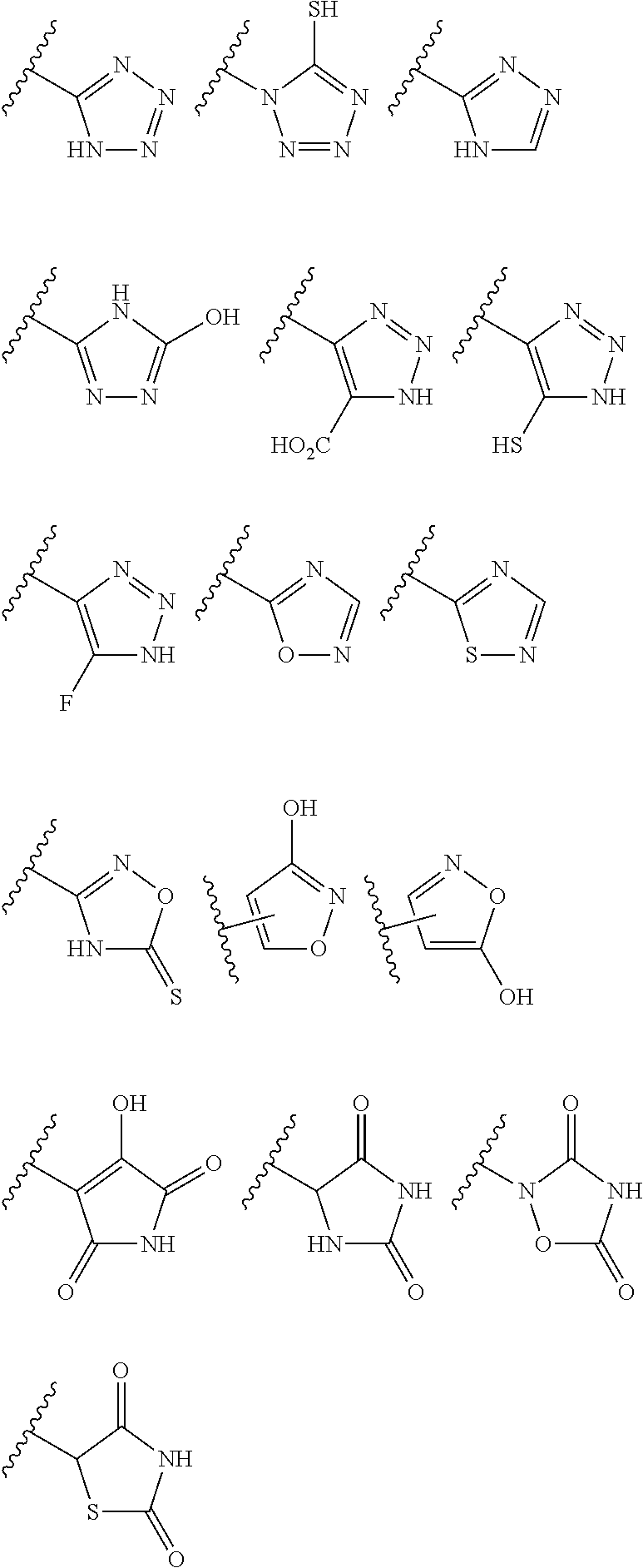Methods of treating bacterial infections
a technology for bacterial infections and compositions, applied in the field of compounds, compositions and methods for treating bacterial infections, can solve the problems of threatening the clinical utility of antibacterial therapy, higher morbidity and mortality, and longer patient hospitalization, and achieve the effect of increasing the sensitivity of a bacterial infection
- Summary
- Abstract
- Description
- Claims
- Application Information
AI Technical Summary
Benefits of technology
Problems solved by technology
Method used
Image
Examples
example 1
Step 1
[0497]A round-bottom flask charged with [Ir(cod)Cl]2 (350 mg, 0.52 mmol) and 1,4-bis(diphenylphosphanyl)butane (446 mg, 1.04 mmol) was flushed with argon. DCM (60 mL), pinacolborane (3 mL, 21 mmol) and tert-butyl-3-(tert-butyldimethylsilyloxy)pent-4-enoate XXXVII [J. Org. Chem., (1994), 59(17), 4760-4764] (5 g, 17.48 mmol) in 5 mL of DCM were added successively at room temperature. The mixture was then stirred at room temperature for 16 h. The reaction was quenched with MeOH (3 mL) and water (10 mL), the product was extracted with ether, and dried. Chromatography on silica gel (100% DCM→50% EtOAc / DCM gave tert-butyl 3-(tert-butyl dimethylsilyloxy)-5-(4,4,5,5-tetramethyl-1,3,2-dioxaborolan-2-yl)pentanoate XXXVIII (5.5 g, 13.2 mmol, 75.5% yield).
Step 2
[0498]To a solution of tert-butyl 3-(tert-butyldimethylsilyloxy)-5-(4,4,5,5-tetramethyl-1,3,2-dioxaborolan-2-yl)pentanoate XXXVIII (5.4 g, 13 mmol) in THF (25 mL) was added (1 S,2S,3R,5S)-2,6,6-trimethylbicyclo[3.1.1]heptane-2,3-di...
example 2
Step 1
[0549]6-(tert-butoxy)-4-[(tert-butyldimethylsilyl)oxy]-1-chloro-6-oxo-1-[(2S,6R)-2,9,9-trimethyl-3,5-dioxa-4-boratricyclo[6.1.1.02,6]decan-4-yl]hexane XLI (515 mg, 0.97 mmol) in THF (5 mL) was cooled to −78° C. under nitrogen. A solution of LiHMDS (1 mL, 1.0 M in THF, 1 mmol, 1.0 eq) was added slowly and the reaction flask was then allowed to warm to room temperature where it was stirred for 16 h. The yellow solution was concentrated under reduced pressure to give an oil. After hexane (10 mL) was added to the oil, a precipitate formed. This was then filtered through Celite and the filtrate concentrated under reduced pressure to give 1-[bis(trimethylsilyl)amino]-6-(tert-butoxy)-4-[(tert-butyldimethylsilyl)oxy]-6-oxo-1-[(2S,6R)-2,9,9-trimethyl-3,5-di oxa-4-boratricyclo[6.1.1.02,6]decan-4-yl]hexyl XLII.
Step 2
[0550]The procedure is identical to that found in Example 1 method D. Compound 7 was isolated as a white powder (120 mg, 0.573 mmol, 59.1% yield). 1H NMR (CD3OD) δ ppm 1.43-1...
example 3
Step 1
[0553]To a solution of tert-butyl 3-hydroxypent-4-enoate, XLVI (674 mg, 3.92 mmol) in DCM (15 mL) was added diisopropylallylboronate XLV(2 g, 11.76 mmol) via syringe. To the mixture was then added Grubbs' first generation catalyst (260 mg, 0.31 mmol, 7.5 mol %) and the vessel was purged with argon. The reaction was heated at 65° C. under nitrogen for 18 h. The mixture was concentrated under vacuum and the residue was purified by flash column chromatography (100% hexane→30% EtOAc / hexane) to afford tert-butyl 2-(2-hydroxy-3,6-dihydro-2H-1,2-oxaborinin-6-yl)acetate XLVII (770 mg, 3.63 mmol, 92.7% yield).
Step 2
[0554]To a solution of tert-butyl 2-(2-hydroxy-3,6-dihydro-2H-1,2-oxaborinin-6-yl)acetate XLVII (670 mg, 3.16 mmol) in EtOAc (45 mL) was added 10% Pd / C (135 mg). The vessel was evacuated by applying vacuum and flushed with hydrogen gas. The reaction was stirred under hydrogen for 2 h. The mixture was filtered through a Celite pad and which was washed with additional EtOAc (1...
PUM
| Property | Measurement | Unit |
|---|---|---|
| minimum inhibitory concentration | aaaaa | aaaaa |
| minimum inhibitory concentration | aaaaa | aaaaa |
| β-lactamase | aaaaa | aaaaa |
Abstract
Description
Claims
Application Information
 Login to View More
Login to View More - R&D
- Intellectual Property
- Life Sciences
- Materials
- Tech Scout
- Unparalleled Data Quality
- Higher Quality Content
- 60% Fewer Hallucinations
Browse by: Latest US Patents, China's latest patents, Technical Efficacy Thesaurus, Application Domain, Technology Topic, Popular Technical Reports.
© 2025 PatSnap. All rights reserved.Legal|Privacy policy|Modern Slavery Act Transparency Statement|Sitemap|About US| Contact US: help@patsnap.com



